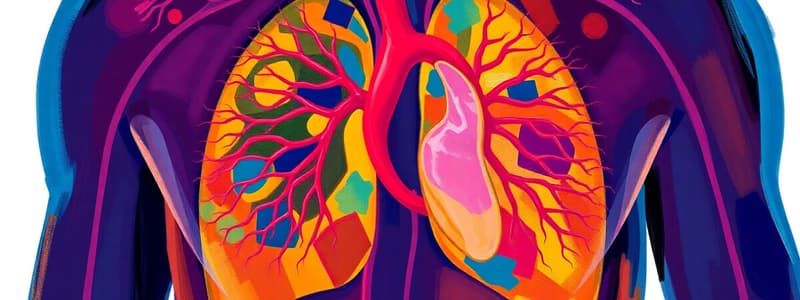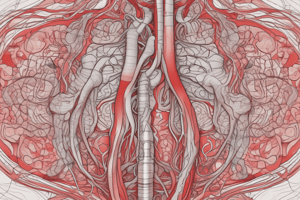Podcast
Questions and Answers
What is the primary function of circulation in the body?
What is the primary function of circulation in the body?
- To produce hormones that regulate various bodily functions.
- To regulate body temperature through sweat production.
- To distribute nutrients and oxygen to all parts of the body and remove waste products. (correct)
- To facilitate the digestion of food and absorption of nutrients.
Pulmonary circulation involves transporting oxygenated blood from the heart to the lungs.
Pulmonary circulation involves transporting oxygenated blood from the heart to the lungs.
False (B)
What is the role of the inferior vena cava in circulation?
What is the role of the inferior vena cava in circulation?
It carries deoxygenated blood from the lower half of the body to the heart.
__________ circulation provides the functional blood supply to all body tissue.
__________ circulation provides the functional blood supply to all body tissue.
Match each type of circulation with its primary function:
Match each type of circulation with its primary function:
Flashcards
Circulation
Circulation
The movement of blood through the body's vessels, powered by the heart's pumping action, delivering nutrients and oxygen while removing waste.
Pulmonary Circulation
Pulmonary Circulation
The system transporting de-oxygenated blood from the heart to the lungs for oxygenation, before it enters systemic circulation.
Systemic Circulation
Systemic Circulation
The system that supplies oxygenated blood to all body tissues, delivering nutrients and removing carbon dioxide and waste.
Study Notes
- Circulation is the movement of blood through the body's vessels.
- Circulation is driven by the heart's pumping action.
- Circulation distributes nutrients and oxygen to all body parts.
- Circulation removes waste products from all parts of the body.
Pulmonary Circulation
- Pulmonary circulation is a system that transports blood.
- De-oxygenated blood is shunted from the heart to the lungs.
- Blood is re-saturated with oxygen in the lungs.
- Blood is dispersed into the systemic circulation after oxygenation.
- Deoxygenated blood from the body's lower half enters the heart via the inferior vena cava.
Systemic Circulation
- Systemic circulation provides the functional blood supply to all body tissue.
- Oxygen and nutrients are carried to the cells.
- Carbon dioxide and waste products are picked up.
- Oxygenated blood flows from the left ventricle, through the arteries, to the capillaries in the body tissues.
Studying That Suits You
Use AI to generate personalized quizzes and flashcards to suit your learning preferences.




